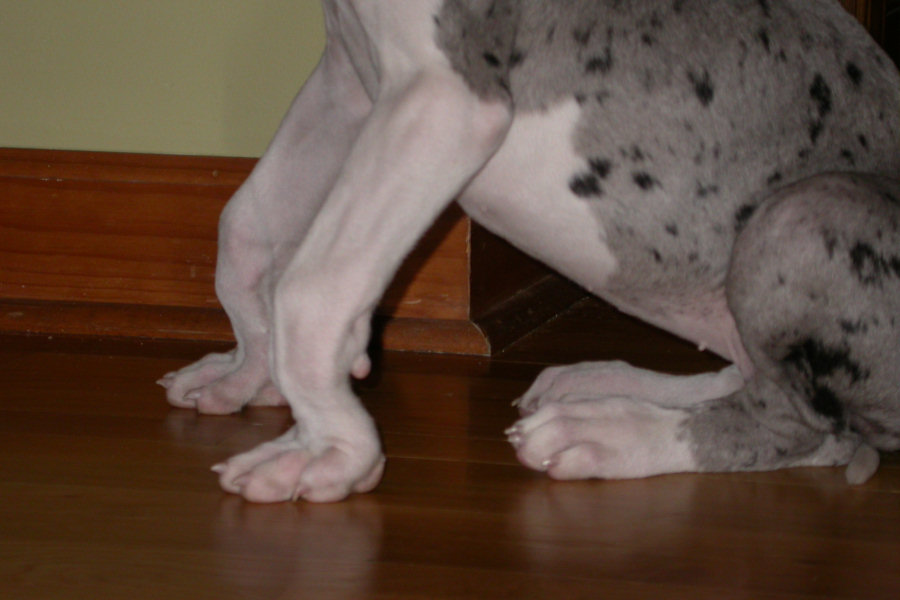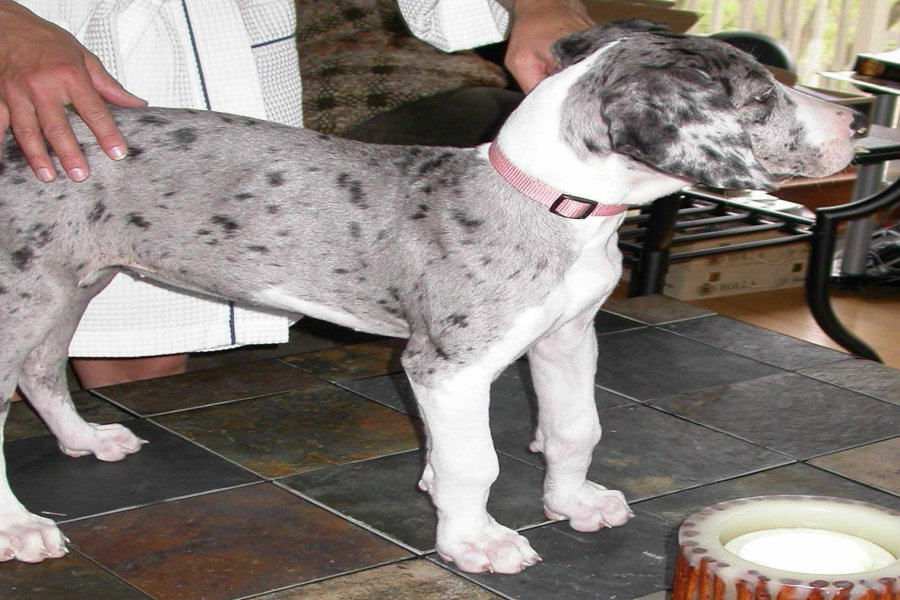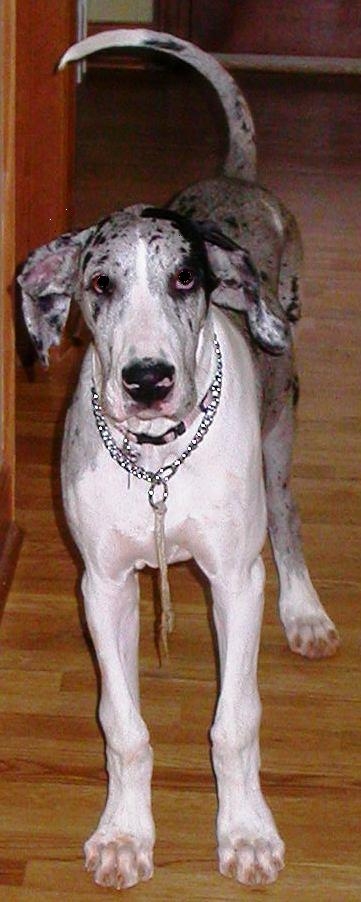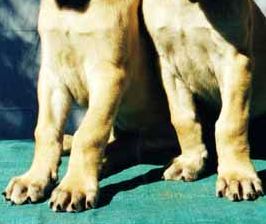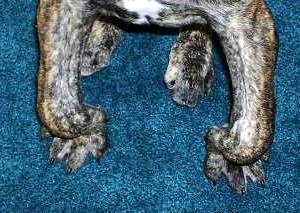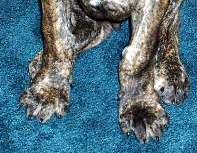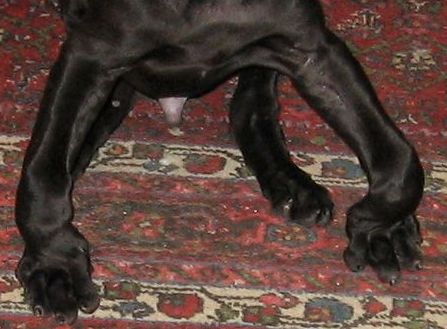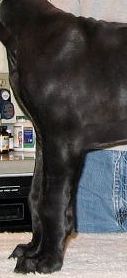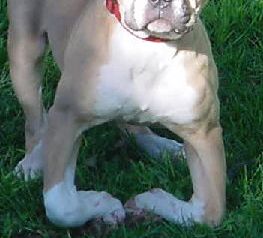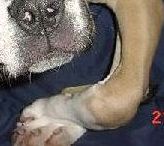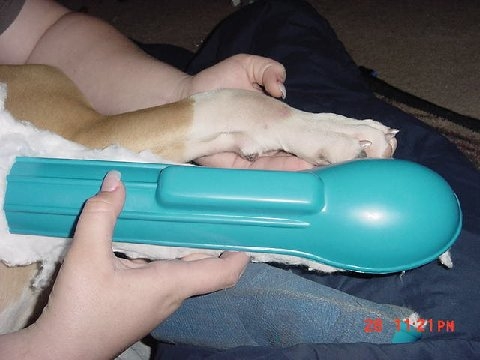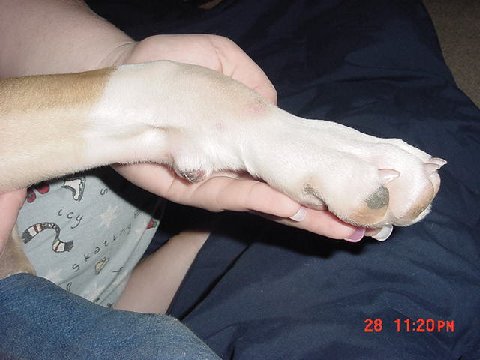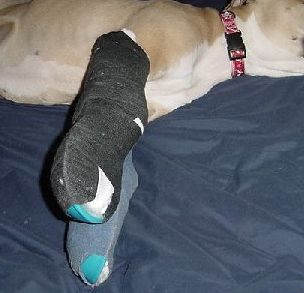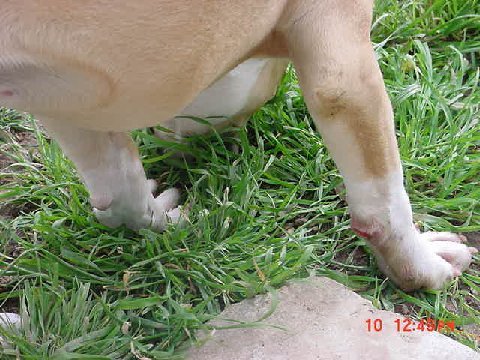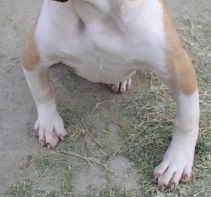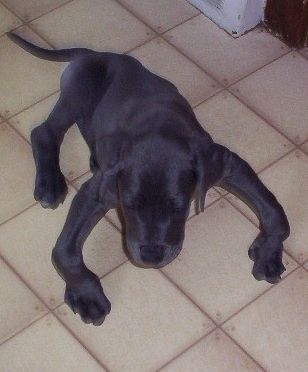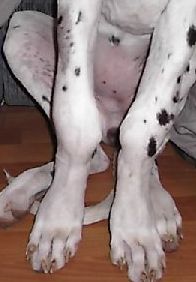We cannot stress the importance over NUTRITION AND TRAINING/SOCIALIZING your puppy.
What To Look For In a GOOD Quality Puppy/Dog Food
1.) Calcium levels at or below 1.2% and Phosphorus levels at or below 0.9%
2.) Protein Level around 24 % (Can be higher 33% if feeding a Grain Free Food or if the protein is coming from meat).
3.) NO PUPPY FOOD unless it meets the above levels!
Older studies thought too much protein is bad and the cause of growth deformities like hip dysplasia, growing pains, knuckling, PANO and HOD. New studies are sayings it’s the Calcium and phosphorus levels causing the issues. So has long as your calcium is at or below 1.2 % and your phosphorus is at or below 0.9% your puppy will have fewer risks of bone and joint issues.
Other Foods we recommend:
1.) Valu Pak (Red Bag 24/20- has corn in it but Soy Free, Silver bag 24/20- is corn and soy free you may have to call and order this one not all dealers keep this one on hand. We get at our Local feed store, you will need to look up for a dealer near you) You can visit their website @ https://specialty-feeds.com/dog-food/valu-pak-dog-food and search your location to see if its carried in your area J
2.) Victor- High Energy (Red bag 24/20. We get at our Local feed store, you will need to look up for a dealer near you). They are other formulas with Victor you can feed as well. We found with the Victor Performance Formula Adult Food with Glucosamine & Chondroitin caused our puppies to knuckle!
3.) 4 Health (Tractor Supply)
4.) Wholesome (Tractor Supply)
What you feed is up to you and what’s best for your puppy/dog (just follow the recommended levels)
All Puppies/Dogs are different what works for one may not work for others. Just watch your puppy/dog for issues, if they occurs then adjust accordingly.

Developmental Orthopedic Disease - Knuckling Over |
UNDERSTANDING THE PROBLEM: YOUR PUPPY SHOULD NOT BE KEPT ON SOLID CONCRETE, TILE OR WOODEN FLOORS WHERE THERE IS NO SURFACE TEXTURE FOR THEM TO GRIP WITH THEIR TOES, AND USE THEIR MUSCLES, LIGAMENTS AND TENDONS PROPERLY. REMEMBER THE FRONT END OF A DOG SUPPORTS THE BODY WEIGHT, THE REAR PROPELS THE MOTION, SO THE FRONT END MUST HAVE TRACTION. SLICK SURFACES ALONG WITH LACK OF EXERCISE AND NUTRITIONAL MONITORING, WILL CONTRIBUTE TO "BOWING IN" AND "KNUCKLING OVER" ON YOUR PUPPIE'S FRONT END ASSEMBLY. WHILE YOUR DOG IS IN THE EARLY STAGES OF DEVELOPMENT (UNDER 6 MONTHS), IT IS BEST TO PURCHASE RUBBER-BACKED THROW RUGS (NO FRINGE AND NO CONTINUOUS LOOP CARPETING, IN CASE THE CHEW IT), SO THEY HAVE SOMETHING TO GRIP WHEN WALKING AROUND, AND YOU CAN WASH THEM WHEN NEEDED. JC PENNEY'S AND KOHLS HAVE GREAT BUYS ON THESE KIND OF RUGS FOUND IN THE BATH SECTION OF THEIR WEBSITE OR STORES. ANOTHER SOUCE IS THE LOCAL GOODWILL OR MISSION STORE. REMEMBER, NOW IS NOT THE TIME TO WORRY ABOUT "DECORATING" YOUR HOME, YOU PURCHASED A PUPPY AND NOW IT'S NEEDS MUST BE MET, MUCH LIKE HAVING TO HOUSE-PROOF YOUR HOME FOR A TODDLER. The term Developmental Orthopedic Disease represents a variety of conditions that occur in young developing canines. Usually this is a problem that occurs in large and giant breeds, but I have seen cases in smaller dogs as well. I will list the conditions in the order in which I have seen them occur in young puppies.
Knuckling over is the first condition normally seen and I will focus this paper on this particular problem. The other conditions listed a different set of problems - all usually nutritionally base and if caught early enough can be corrected with a comprehensive feeding program for Knuckling Over Knuckling over is first noticed in the area of front leg on a puppy, or the growth plate (wrist or carpal) area. The term coined by professional breeders for this condition is knuckling over, and it describes a condition where the front end assembly of the dog, the weight bearing part of the body, is unable to support the whole body weight of the puppy, due to a lack of integrity in the muscle, tendon and ligaments. It is my opinion this condition is not genetic - it is due to uneven growth pattern between the bone and tissue/muscle of the puppy and it is cause by dietary imbalances and/or missing micro-minerals and/or minerals that are not available to the body - difficult to assimilate. The condition of " knuckling over", can be very extreme, almost as if the legs are made of some malleable material - like rubber! Early knuckling over - under 8 weeks of age, is not a problem and very common because the large and giant breeds grow quickly during the early stages of development. Once a puppy reaches 8 weeks of age they need to be separated from the litter during meal time, so you can keep track of the amount of food being consumed and it is during this period that we start to see the beginnings of extreme knuckling over. I have noted this problem has 4 stages in terms of degrees, and I am happy to report, if owners contact me early enough and put them on the Blackwatch Puppy Feed Program for Knuckling/Bowing - HOD Kit#5, and in some cases do wrapping and supports, we can turn them around very quickly - 2 days - 2 weeks depending on the age and length of time they have been this way. Breeders often think growth issues are cause by too high a protein in a diet and that is not the case at all, and research shows us this is not true. When you do not have this correct equation in a diet, it causes uneven growth patterns between muscles, ligaments, tendons and bones. They are all developing at different rates - the end results are severe knuckling over and this grotesque deformation can be permanent if not taken care of in the early stages. This does not only effect the carpal/wrist area, but can also the shoulder area (see below photos). Before change of diet to Blackwatch Puppy Feed Program and wrapping with vet wrap.
Left: 11 days later she can support her own body weight. Warps are checked every 2 days. Here are resources for leg wraps and supports for serious problems that can not be taken care of with normal vet wrap http://www.dogleggs.com/or www.orthovet.com For a dog with cruciate ligament issues, it is no longer necessary to do surgery in many of these cases. With the support of a A-TraC Dynamic Brace and good diet to feed, the dog can get around very well. Knuckling OverLevel 1
Puppy on the right, shows the inside leg as an example of the beginning of the early knuckling over we see at 5 - 7 weeks of age. This is not at all unusual and often corrects itself as the dog matures to 8 - 9 weeks of age, provided they are on the right diet. There will be some vacillating back and forth during the time of vaccines and ear cropping, the stress of all of this and the fast growth they go through all contribute to the problem. . Level 2
On Left: 8 weeks On Right: 9 weeks after being wrapped and a change in diet, this dog is able to support his own weight. Level 3
8 weeks on left , then with wrapping and a change in diet and it is corrected at 9 weeks Level 4
On left is at 9 weeks and unable to stand and support his own weight. With a spoon splint, wrapped and change of diet you can see in 12 days this dog's leg can be straightened out. Only in extreme cases do we have to brace the whole foot, in this case the dogs toes were curled and deformed, so we needed to straighten them out so he could support his weight. He was only left in a spoon splint for 3 days then moved to a splint that allowed his foot normal movement.
This is an image of the spoon splint that was put on behind the dog's leg in order to straighten it out. The photo on the right is 3 days later, and the dog's leg is straight. Sometimes, as in level 4 problems, we need to splint the whole foot because the dog's toes are curled under and can not support the weight of the dog. This problem can effect any large/giant breeds - it can happen to smaller breeds as well.
Left are examples of the bracing of this dogs legs and feet. After 12 days in a brace (checked every 2 days) and a change to Blackwatch Feed Program ,this problem is corrected to the point the animal can now support his own weight on his feet. In order to correct level 3 and level 4 of knuckling over, it is mandatory to change the dogs diet, control the amount of food consumed and allow free exercise. It may also be necessary to wrap the shoulder area with vetwrap, as well as the growth plate or wrist area on the dog. When the dog can't get traction due to his weak shoulder muscles, it is important to bring the legs under the dog and support with some kind of wrapping brace - images below. Have your vet help you with this so it is not too tight to obstruct breathing but will hold in the legs much like a hobble for horses...and get the dog off of slick, hard surfaces!
What Causes This Extreme Knuckling Over?Knuckling over is caused by the following: 1) a combination of two different types or brands of dog foods - feeding (50/50) WHAT TO FEED MY PUPPY AND WHAT SUPPLEMENTS ARE NEEDED TO CORRECT THIS PROBLEM? When switching to Precise Holistic Complete L/G Puppy Formula, do so quickly by starting with a 50/50 mix for the first feeding, then 100% of the new PHC Large/Giant Puppy Formula at the next feeding. If you can not locate the Precise Holistic Complete Large/Giant Puppy Formula, you can use one of the Precise Holistic Complete "Wild at Heart Kibbles" because they are all life stage formulas and will support growth. I can't get this problem corrected on other foods. These dogs grow so fast, even a slight adjustment in foods, supplements or amounts can throw their system into a tizzy. This is a problem of rate of growth being out of sync between the bones, muscles, ligament and tendons of the shoulder and wrist/carpal area. Amount to Feed: Giant Breed Puppies use the mid- range and for Large Breeds Puppies |
Pano is known as Wandering Lameness or Eosinophilic Panosteitis, and is due to rapid growth.... and it also happens in fast growing children, particularly males. Pano is a self-limiting disease and will have spontaneous recovery in time. If left too long without a change in diet to reduce the pain there will be muscle wasting, something we want to avoid. The age for this condition can be from 6-14 months in large and giant breeds, with most cases seen from 9-12 months. We fix this problem by assessing the feeding program you are currently on, then make recommendations for changes to help the support of your dog's developmental growth. This may involve a change in brand and amount of food and will mean some supplements to rebalance the system so the growth patterns are slow and even.
Pano or Panosteitis is the least threatening of the developmental orthopedic diseases. Pano is due to excessive growth rate which effects the long bones of the legs and often switches legs from day to day. This is from consuming too many calories than is actually needed by the body, or eating a diet with poor quality minerals, a mineral imbalance or lacking micro minerals. We can stop this condition quicker by slowing the growth rate with an appropriate quality food in measured amounts, adding MSM-Nutritioinal Sulfur to the diet to help with malabsorption issues, and Dietary Enzymes to help with inflammation. Please do not use Rimadyl or Deramaxx on this breed. They are fragile enough without compromising their liver functions.
ALERT: An allergic reaction Chephalexin or the Sulfonamide antibiotics is often misdiagnosed as HOD or Pano in young AND adult dogs. True Pano does not happen in dogs after the growth plates are closed at 18 months, but an allergic relation to antibiotics can happen at any stage of the dogs life and mimic of Pano or HOD.
1.DOG FOOD FOR PANO -The food I want you to try and locate for your dog with Pano, is Precise Holistic Complete Large/Giant Breed Puppy Food which is a 23%protein/12% fat. I helped to design this food specifically for slow growth in these big dogs. Then once the dog is past 12 months you can move to any of the other Precise Holistic Complete foods.
You can locate a retailer by going to the Precise website www.precisepet.com
2. SUPPLEMENT KIT FOR PANO - All Ages & Breeds
The supplement kit your will need for Pano is called CORE 4 Kit #5 and it can be purchased at www.firstchoicenaturals.com or you can call in and order it at
1-877-343-2704. They always have customer care to help with questions and they only hire people who are also seasoned dog breeders and exhibitors. They know what it is like to have to deal with dog problems and questions.
3. OPTIONS FOR VARIETY - To add some variety to your dogs life, use a holistic canned food or a dehydrated RAW meat diet because it is balanced in calcium and phosphorus as well as tested for pathogens and parasites, unlike what you get from the store. I like to use Honest Kitchen Dehydrated Raw Foods, this allows me to use a component of raw along with my Precise kibble and it includes fruits, veggies and botanicals. I like the Embark, but they have several others that work (Force, Thrive, Keen, etc). so you can rotate for variety and sounder nutritional practices. If you are into feeding a totally raw diet or raw with your kibble the brand I use and recommend is Darwins - and the ship it right to your door. Again, Please do not feed growing large and giant breeds a totally raw diet until they are past their drastic growth stages - 10 months. 4 lbs of dehydrated raw makes up to 17# of wet food!
Other options, use wholesome human foods such as yogurt, buttermilk, kefir, cottage (not daily), scrambled eggs, berries, melons, peaches, apples, banana, tomato, broccoli, cauliflower, squash, sweet potato (not for dogs with yeast issues), green beans, peas, zucchini are all things your dogs can have with their daily food. Pulverizing veggies helps them to digest it better or lightly steam them is an option. Mine love homemade veggie soup and it's great as a filler for dogs with weight issues. Garlic is ok to use as well as avacado meat (not the skin or pit!!)
Linda's Very Veggie Soup For Variety or Weight Loss - 2 large cans of Organic chicken or beef broth - (low sodium for heart or elderly dogs- or homemade). Add LOTS of veggies - carrots, green beans, wax beans, peas, carrots, kale, zucchini, squash, tomatoes, cabbage, broccoli, cauliflower and couple cloves of garlic and Celtic Sea Salt (only this type). The idea is to use this as the filler so you want it to be hearty and filling.
Warning: NO raw onions, grapes, raisins, chocolate or macadamia nuts. Keep sugar free gum and candy out of access to your pets because they have Xylotil sweetner in them which can kill your pet.
So What is HOD?
HOD - Hypertrophic Osteodystrophy - in lay terms simply means "swollen joints"- so before your vet can treat this, we need to determine the cause - many things can cause swollen joints in a young growing puppy. Diagnosing HOD can be very difficult and confusing for your vet because several conditions can "mimic" the symptoms of HOD and they may not be familiar with that information.
These are the things that can cause HOD- like symptoms:
Diet -a caloric dense diet and your dog is being over fed; intake vs output,and/or an imbalance in the diet due to addition of certain vitamin/minerals or human foods such as calcium tablets, meat, rice, cottage cheese. And/or a diet with no chelated minerals which means the body can't utilize these nutrients properly causing malabsorbtion of nutrients, either due to quality of macro-minerals or lack of micro-minerals in a diet, which are necessary for macro-minerals (Calcium/Phosphorus/Magnesium) to work properly. A dog can come down with HOD if you change dog food brands more than twice during delicate growth periods 10 - 16 weeks.
Blood infections - Septicemia/Septic-Arthritis - Have a blood test done immediately to rule out infection, this is by far more important than an x-ray. You already know the dog has swollen joints, if you have to make a choice between an xray and blood test due to financial reasons, a blood test is more important in ruling out infection. Keep in mind that pain alone can elevate the white cell count a little, it is significant elevated white cell counts that indicate infection. Editorial Comment:I NEVER recommend tapping a joint with a needle to check for infection, this is antiquated method. Once you break that seal in the joint area it is very vulnerable to staph infection in the joint, as well as early arthritis.
Vaccine reactions - multivalent/combination vaccines are an enormous problem with young dogs with immature immune systems, especially if the dogs have not received adequate amounts of a antioxidants to help the body to detoxify from being bombarded with combination shots. It is even more of a problem when Lymes Vaccine or Rabies Vaccine has been at the same time as the combination shots. Rabies given before 6 months of age is not recommended for Great Danes (Purdue Vaccine Study) and should be given alone. In some states it means breaking the law if you follow this protocol. Discuss it with your vet first and if you are not comfortable with waiting until 6 months or older at least back up the system by using antioxidants (Vaccine Prevention Information).
Allergic reaction to certain antibiotics ( Sulfonamides or Cephalexin). Sulfonamides seem to be a problem for many Great Danes, Dobes, Goldens and perhaps other breeds. I do not recommend it's use unless this family of drugs is absolutely necessary (based on a blood culture) for a specific pathogenic bacteria. (Research References). Cephalexin on the other hand, although a good broad spectrum antibiotics, can also produce HOD like symptoms because it dries out the synovial fluid of the joints. My suggestion is to use something else if you have a choice and wait until more mature to use this drug. Adult dogs can have HOD like symptoms on Chephalexin as well. If you have to use this drug, use it with a watchful eye, and if the dog acts achy or lethargic, stop the use of the drug.
What You Need To Do First:
1). To correct this problem switch to Precise Holistic Complete Large Breed Puppy Food 23% protein 12% fat. If you are unable to locate it in your area by going to this website: www.precisepet.com
When switching foods do so quickly - use 50/50 the first feeding then 100% of the new food. It's important to use probiotics (see kit below) when switching food so they do not get a loose stool. In the meantime, what ever food you are on, cut back the amount you are feeding!
What If I Can't Find Precise Foods?
Check this list for approved foods for large/giant breed growth.
AMOUNT TO FEED CHART. (print this out) - now if you are currently feeding out side of this range that is recommended, that is part of this problem if not all of it. So cut back if the dog is inactive. As long as the dog is inactive you should not feed full recommended amount. Ex: if the dog is normally eating 4 cups a day, cut back to 3 cups.
NOW YOU NEED TO ORDER :
2). the HOD/Knuckling Over Supplement Kit#5
HOD - 12 weeks - Clare
Please take the dog to the veterinarian for a diagnosis and make sure they run a blood test to rule out a serious blood infection - septicemia/septic-arthritis and get an xray.
If it were my dog and a vet wants to "tap the joint" with a needle I would never allow it. I would search for another vet. You do not want to risk getting staph infection into that joint by breaking the seal , grab the dog and run to another vet!!
Great Danes often have reactions to the Sulfonamide family of drugs so you need to let your vet know this and it might not be the best kind of antibitoic to use, if septicemia is the issue. They often have a reaction to Chepalexin/Keflex as well, so this much be watched very carefully and only used knowing it can worsen the HOD like symptoms. (info below)
If it were my pet, would not use an antibiotic unless the vet says there is an elevated blood count, one that indicates infection and not just slightly elevated due to the pain.
1. After you line up your recommended food....2. After you order the HOD Kit#5 on line or call1-765-284-8288m it will be shipped priority mailthe same day.3. Fill out this form HOD FORM and send it to: 1stchoicenaturals@comcast.net - this is also theplace where you can make an appointment for a consultation with me. 1-765-284-82884. Send a photos of the dog in JPG format - front joints, standing if possible, laying is OK too as long as I can see the joints. Front and back knee area. Note the photos are property of Blackwatch Nutritionals LLC and if used in educational seminars or publications, I respect your privacy and do not use names of owners or dogs and crop photos so it is not recognizable by the public. These are used to help educate others about this problem, the cause and how to reverse it.
Foods that will NOT work: Innova, EVO, any raw diets, Hill's Science Diet, Iams, Eukanuba, Pedigree, Purina- Proplan, Diamond, Kirkland, Ole'Roy, Costco Brand, Authority, Sam's Club, Nutro, or any grocery store level food will not work. And even several of the holistic foods due to their calcium levels.
NOTE: Eagle is no longer owned by the Cocoquyt family, it is owned by Wellpet LLC a large conglomerate company and I can't endorse it bcecause we don't know if it is truly the same quality it once was or if recipes are the same.EVEN THOUGH A BAG OF DOG FOOD SAYS "LARGE BREED PUPPY" DOES NOT MEAN THERE IS ACTUALLY SCIENCE BEHIND IT OR FEED TRIALS DONE ON A FOOD ON LARGE/GIANT BREEDS.NOT all Large Breed foods are appropriate for growth and not all adult foods are appropriate for puppies.
Fourth Step - Getting A Jump Start
While you are waiting for your HOD Kit #5 to arrive and food to come, go to a health food store, or Walgreens pharmacy or Wal-Mart pharmacy area and get things to get you started until you get ordered. These are not the same quality but at least will give your dog a jump start on correcting the problem.
Vitamin C or Ester C - 500 mg daily with food
Probiotics - Purchase a "multiple beneficial bacteria" Probiotic product from the refrigerator section of the health food store - (acidophilus) and double dose for 2-3 days, according to the container for an adult human - then just once a day to get the flora of the gut established.
If you do not have a health food store, ask the pharmacist for help...you want a Probiotic or Lactobacillus Acidophilus product. Yogurt does NOT have enough cultures or guaranteed living cultures so don't bother to use it for this purpose.
Purchase a small bottle of MSM- Nutritional sulfur start dosage 1000 - 1500 mg daily divided into two meals. MSM is critical in helping with malabsorption of nutrients/minerals.
When your HOD Kit#5 comes - you can discontinue these band-aid supplements. You personally can take the balance of these vitamins listed above, for yourself so there is no waste and it's better for you anyway. You might consider a Wellness program for you as well.
SUPPLEMENT SCHEDULE:
Ten Tips for Effective Great Dane Training
Great Danes are a giant breed of dog. Due to their size and strength, it is very important to train them starting at a young age. 8 to 12 weeks old is appropriate to begin with the basics that any dog should know; come, sit, stay and no. Your Great Dane may need to know a few commands that your average sized or small dog might not need, like heel, down and gentle as well as socialization training and perhaps crate training. Your Great Dane training should contain these 10 tips.
1. Great Danes (as well as any dog with a deep chest) are prone to a medical condition called bloat or gastric torsion. This can become deadly and it is therefore very important NOT to teach your Great Dane to roll over.
2. Do NOT punish your Great Dane (or any dog for that matter). A simple stern “no” is all it should take if they do something wrong. Yelling, hitting or other negative actions can create what is termed as a “fear biter,” and the ones that usually get bitten are the owners or innocent bystanders.
3. The heel command is necessary for Great Dane training. Your Great Dane will need mild exercise at least once a day and the best way to do that is to go for a walk. To teach your new best friend to heel, begin with the sit command and when they are still and calm, begin to walk, give a gentle tug on the leash and say “heel.” If your Great Dane pulls or gets too rough, come to a dead stop and get them to sit again. Lather, rinse and repeat.
4. Counters and tables are the perfect height for most Great Danes. Commands like off, no and down are important to include in your Great Dane training.
5. Your Great Dane training should account for their sensitive nature. Great Danes can suffer from separation anxiety perhaps a bit greater than other more independent dogs. You can desensitize them by leaving the room and coming back when they are calm. Slowly increase the time that you are gone.
6. Crate training is another good form of Great Dane training that may be useful to keep them from getting into trouble or suffering from separation anxiety. Be sure to get a crate that allows them to stand and turn around in.
7. Don’t forget to praise your Great Dane when they get it right. Positive reinforcement works well with Great Danes.
8. Be patient and consistent when you work your way through Great Dane training. Great Danes are smart and learn things well. They want to please their owners and they will understand what you want them to do, eventually.
9. Give them the proper medical attention that they need. Unhealthy dogs are more prone to behavior problems and it’s not their fault. If your Great Dane is urinating in the house unexpectedly, you may want to take them to the vet.
10. Finally, the Great Dane is an awesome pet for the family or the individual. Your dog training should include socialization as they can be protective and territorial. They need to know how to behave around strangers and other dogs as this breed can be a little aggressive towards them. Your behavior and attitude toward them is the best way to instill good Great Dane training behaviors. By following these basic instructions your Great Danes true personality will begin to unfold and you will see a marked improvement in your companionship. As your puppy grows, so will your bond. When trained properly, these gentle giants can leave a lasting impression on anyone they encounter.
Ten Tips for Effective Great Dane Training courtesy Dog Articles - http://bit.ly/i9RCOd

|
bloat.pdf Size : 54.667 Kb Type : pdf |
Preventing Bloat
Pulling back the curtain on veterinary life since 2008.
Posted by Chris Bern, DVM at 9:36 PM ![]()
This is just some information we pulled off the internet explaining at what age is recommended to spay/neuter your DANE!!!
Talking frankly about spay/neuter is worth the backlash however because the health risks associated with it, especially when done in a young dog, are worthy of discussion. That isn’t to say that dogs shouldn’t be spayed or neutered; that’s a personal decision best left to the pet owner. Like vaccines and most routine veterinary procedures however, vets spend a lot of time discussing why you should spay or neuter your dog, but spend very little time talking about why you shouldn’t. The goal of this article is to give you the information your vet doesn’t, so you can make the best possible decision for your dog.
I’ll preface the article by stating that I breed Labrador Retrievers, a breed that can be prone to hip and elbow dysplasia, as well as cruciate tears. The families that get one of my puppies receive a warranty of sorts, saying that I have done everything I can to prevent these issues and if, despite my best efforts, the puppy I’ve bred ends up with a debilitating joint issue, I will refund the purchase price to the puppy’s family.
There is one disclaimer however and it’s as follows: if the family decides to spay or neuter the puppy before 24 months of age, my warranty is null and void. The reason is that research shows I can’t guarantee the puppy’s joints won’t be affected by this seemingly simple medical procedure. Spay neuter and joint disease are now shown to be related and this surgery has the capability of permanently changing a healthy puppy joint into an unhealthy one.
Abnormal Growth
At the heart of the matter is how spay/neuter affects the dog’s hormones. When a dog’s reproductive organs are surgically removed, the sex hormones they produce also disappear. The sex hormones are responsible for more than just sexual behaviors and one of their responsibilities is regulating growth.
Breeders can readily spot the difference between an intact dog and a neutered dog: neutered dogs have longer limbs, narrower heads and bodies, and they are lighter in bone. When the sex hormones are removed, the growth hormones are missing important regulatory input and the bones continue to grow longer than they ought to. Studies have proven this to be true (Salmeri et al, JAVMA 1991).
In each long bone there is a growth (epiphyseal) plate, which is a band of cartilage found near the joint. This growth plate lays down bone as a puppy develops and, as it builds bone, the bone becomes longer and the puppy gets larger and taller. Once maturity is reached, this growth plate turns into bone and the puppy’s full height is reached.
When dogs are sterilized before maturity, the closure of some but not all growth plates may be delayed and this would be especially true if a dog is sterilized when only some of his growth plates are closed.
The dog’s elbow and stifle joints are similarly designed. Above each joint is one bone (the humerus and femur respectively), and below are two bones (in the elbow there is the radius and ulna and in the stifle there is the tibia and fibula). One bone effectively sits on two. What would happen if one of those bones underneath the joint stopped growing before the other bone and they ended up being different lengths? It would be very much like building a house on a slope: the weight of the home wouldn’t be evenly distributed and there would be increased load at the lowermost corner of the house.
The same could very well happen in the elbow and stifle joint when closure of the growth plates is artificially delayed and this could in turn lead to increased risk of both elbow dysplasia and cranial cruciate ligament tears.
There is research that supports this. Whitehair et al (JAVMA Oct 1993), found that spayed and neutered dogs were twice as likely to suffer cranial cruciate ligament rupture. Slauterbeck et al also found an increased risk (Clin Orthop Relat Res Dec 2004).
Chris Zinc DVM PhD DACVP explains, “…if the femur has achieved its genetically determined normal length at eight months when a dog gets spayed or neutered, but the tibia, which normally stops growing at 12 to 14 months of age continues to grow, then an abnormal angle may develop at the stifle. In addition, with the extra growth, the lower leg below the stifle likely becomes heavier (because it is longer), and may cause increased stresses on the cranial cruciate ligament.”
Additionally, sterilization can cause a loss of bone mass (Martin et al, Bone 1987), and obesity (Edney et al, Vet Rec Apr 1986). Both of these factors could lead to an increased risk of cranial cruciate ligament tear. Furthermore, spayed/neutered dogs are greater than three times more likely to suffer from patellar luxation (Vidoni et al, Wien Tierartztl Mschr 2005).
Hip Dysplasia
The thought of hip dysplasia is enough to strike fear into any large breed dog lover. For that reason, the bulk of research on spay/neuter and joint disease is focused on this disorder.
Dogs who are sterilized before the age of six months have a 70% increased risk of developing hip dysplasia. The authors of this study (Spain et al, JAVMA 2004), propose that “it is possible that the increase in bone length that results from early-age gonadectomy results in changes in joint conformation, which could lead to a diagnosis of hip dysplasia.”
There is more evidence that spay/neuter can increase the risk of hip dysplasia. Van Hagen et al (Am J Vet Res, Feb 2005), found that of the sample dogs diagnosed with hip dysplasia, those that were neutered six months prior to the diagnosis were nearly twice as likely to develop hip dysplasia.
Interestingly, a study by Dannuccia et al (Calcif Tissue Int, 1986), found that removing the ovaries of Beagles caused increased remodeling of the pelvic bone, which also suggests an increased risk of hip dysplasia with sterilization.
Osteosarcoma
Although not technically a joint issue, osteosarcoma is a cancer of the bone. This bears mentioning because spayed and neutered dogs are twice as likely to develop this deadly disease (Ru et al, Vet J, Jul 1998).
In another study, male Rottweilers, a breed susceptible to osteosarcoma, were nearly four times more likely to develop osteosarcoma than intact dogs (Cooley et al, Cancer Epidemiol Biomarkers Prev, Nov 2002). In fact, Rottweilers spayed or neutered before one year of age had a 28.4%(males) and 25.1% (females) risk of developing osteosarcoma. Interestingly, the researchers concluded from their results that the longer the dogs were exposed to sex hormones, the lower their risk of osteosarcoma.
Playing Roulette
There are other related risks with spay/neuter, including an increased risk of many cancers, hypothyroidism, diabetes, urogenital disorders, cognitive impairment, obesity and adverse vaccine reactions – not to mention the risk associated with the surgery and the anesthetic. These risks should all be considered when it comes time to decide if spay/neuter is an option for your dog.
What does seem to be clear is that the risk of joint disease in particular is greatly exaggerated if the dog is sterilized before the growth plates close. It’s important to remember that the sex hormones do play a synergistic role in your dog’s growth and development and their removal will create imbalance in the body. Just what the fallout from this imbalance entails remains to be seen, as research into the effects of sterilization is in its infancy, even though hysterectomies on humans and spay/neuter on dogs has been accepted as a normal procedure for decades!
The age at which the growth plates close is entirely dependent on the dog and the breed. In general, the larger the dog, the later the growth plates will close. In giant breeds, this could be nearly two years of age.
Conclusion
Getting back to my puppy contract, given the above research, I simply can’t guarantee the puppies I breed will have healthy joints if they are spayed or neutered, especially before the age of two. Whether the puppy’s family decides to keep their dog intact or sterilize him after that age is entirely up to the family. I do an extremely good job of screening the homes that apply for one of my puppies and if they aren’t responsible enough to keep an intact animal, they certainly aren’t responsible enough to deserve one of my precious puppies in the first place.
People who are involved in rescues and shelters may have a different view on this and they are certainly entitled to it. When considering if and when your dog should be spayed or neutered however, it’s important that you make the decision based on facts and try to steer clear of an emotional response that may affect the health and longevity of your dog. It’s really not for me – or your vet – to dictate what you should do with your dog.
Happily, there are alternatives to the complete removal of the sexual organs. Vets are starting to experiment with zinc injections to sterilize male dogs. This leaves about half of the circulating testosterone available to the body. Vasectomies and tubal ligations are also becoming more popular and they have the happy consequence of less interference with the sex hormones – and your dog gets to keep his reproductive organs right where nature intended them to be.
You have a choice in whether and when your dog is spayed or neutered and how important it is to you that his/her sexual organs and hormones remain in place. Once your dog is spayed or neutered, you can’t reverse your decision, so dig a little deeper and you just might find a solution that you and your dog can live with, happily and healthfully.
When Do I Spay and Neuter?
You will hear many ideas about spaying neutering. All I can do is tell you my experience with this and what I tell my puppy buyers. When males are neutered too young, before their hormones are full tilt, they do not gain the muscle that an adult male should have and look like a gangly puppy their whole life. I do not recommend neutering a male until at least 12 months of age.
As for females and spaying, there are two thoughts on this....one says to spay early so they do not develop breast cancer. In my almost 30 years in dogs, and working with breeders, this is a rarity. But what is common, very common when you spay a bitch before she comes into season the first time, they almost always have are problems with incontinence and this is very hard to deal with.
This is also regulated by hormones and if they do not have the appropriate hormones present, they will dribble or wet the bed a night, even as a young female. SO......I tell my puppy buyers to let them be at least 12 months of age before they spay, again so their hormones are in gear. If they have a season before this, then you simply have to make arrangements for boarding them so they don't get breed.
When the girls come in season, give them Chlorophyll tablets daily, give a human dose but double dose it daily during the time they are in season (all 21 days). This will cut down on the odor, but NEVER leave them unattended at any time for the 3 weeks they are in season. NEVER!!
Also….NEVER spay a female during any of her estrus period. That means when she is coming into season, when she is IN season, and for the two months after! During those two (2) months after, her hormones could be raging which causes a false pregnancy. In her mind she is pregnant! They will often nest and have milk, as well as carry around a toy as if it were a puppy. During this 3+ month time period of total estrus (before, during, after), they should not have surgery done, UNLESS it is pyometria infection (uterine infection) or other life threatening reasons. They are very susceptible to bleeding to death (DIC) during surgery, if it is done at a time when her hormones are fluctuating. So plan your spay dates very carefully.
http://www.greatdanelady.com/articles/spay_and_neuter_information.htm
